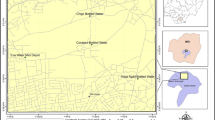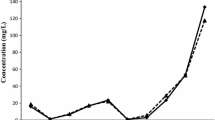Abstract
Bottled water is one of the major drinking water sources for travellers in tourist hubs in Sri Lanka. In this study, 32 major bottled water brands sold in the country were analyzed with 19 parameters by means of atomic absorption spectrometer, spectrophotometer and titration. The main objective of the present study is to investigate geochemical variations of Sri Lankan bottled waters in order to identify the main geochemical processes. A comparison of the element concentrations and the legal limits (Sri Lanka, US EPA and WHO) shows that only magnesium level in one brand is above the lower level set by Sri Lankan Standard. According to classifications based on European Union mineral water directive, all the brands indicate low mineral content (TDS 0–150 mg/L) and they are suitable for low sodium diets. Hardness of the water fluctuates within soft water (25 brands), moderately hard water (6 brands) and very hard water (1 brand). Accepted water quality classification systems were used to characterize the different bottled water types. Piper and stiff diagrams were used to establish that the dominant chemical types of the bottled waters are magnesium–calcium–bicarbonate (11 brands), magnesium–calcium–sodium–bicarbonate (9 brands), sodium–magnesium–chloride–sulphate (4 brands) and sodium–chloride–sulphate–bicarbonate (3 brands). According to dietary reference intakes, all the bottled water brands are significantly lower than the recommended human mineral requirements. This means that the bottled waters available in the country are useful for low mineral diets rather than sources for the necessary mineral intake.




Similar content being viewed by others
References
Ahmed F, Bibi MH, Ishiga H, Fukushima T, Maruoka T (2010) Geochemical study of arsenic and other trace elements in groundwater and sediments of the Old Brahmaputra River Plain, Bangladesh. Environ Earth Sci 60:1303–1316
Allen HE, Halley-Henderson MA, Hass CN (1989) Chemical composition of bottled mineral water. Arch Environ Health 44:102–116
Al-Saleh I, Al-Doush I (1998) Survey of trace elements in household and bottled drinking water samples collected in Riyadh, Saudi Arabia. Sci Total Environ 216:181–192
Aral MM, Maslia ML, Ulirsch GV, Reyes JJ (1996) Estimating exposure to volatile organic compounds from municipal water-supply systems: use of a better computational mode. Arch Environ Health 51:300–309
Azoulay A, Garzon P, Eisenberg MJ (2001) Comparison of the mineral content of tap water and bottled waters. J Gen Intern Med 16:68–175
Balbus JM, Lang ME (2001) Is the water safe for my baby? Pediatr. Clin North Am 48:1129–1152
Calabrase DM (1997) Bottled H2O. Better Nutr 59:46
Cidu R, Frau F, Tore P (2011) Drinking water quality: comparing inorganic components in bottled water and Italian tap water. J Food Compos Anal 24:184–193
Crittenden JC, Trussell RR, Hand DW, Howe KJ, Tchobanoglous G (2005) Water treatment: principles and design, 2nd edn. Wiley, New York
Dharmagunawardhane HA, Dissanayake CB (1993) Fluoride problems in Sri Lanka. Environ Manag Health 4:9–16
Dissanayake CB (1991) The fluoride problem in the groundwater of Sri Lanka-environment management and health. Int J Environ Stud 38:137–155
Dissanayake CB, Chandrajith R (1999) Medical geochemistry of tropical environments. Earth-Sci Rev 47:219–258
Dissanayake CB, Munasinghe T (1984) Reconstruction of the Precambrian sedimentary basin in the granulite belt of Sri Lanka. Chem Geol 47:221–247
Ensafi AA, Kazemzadeh A (1999) Simultaneous determination of nitrite and nitrate in various samples using flow injection with spectrophotometric detection. Anal Chim Acta 382:15–22
Environmental Protection Agency (EPA) (2009) National primary/secondary drinking regulations. EPA 816-F-09–004. 6 p. http://www.epa.gov/safewater/contaminants
Food control administration unit (FCAU) (2013) List of bottled water manufactures and their brand names with valid registration. http://203.94.76.60/FOODWEB/index.html
Gulson BL, Sheehan A, Giblin AM, Chiaradia M, Conradt B (1997) The efficiency of removal of lead and other elements from domestic waters using a bench-top water filter system. Sci Total Environ 196:205–216
Herath AT, Abayasekara CL, Chandrajith R, Adikaram NKB (2012) Temporal variation of microbiological and chemical quality of non-carbonated bottled drinking water sold in Sri Lanka. J Food Sci 77:160–164
Kuo HW, Chiang TF, Lo II, Chan CC, Lai JS, Wang JD (1997) Exposure assessment of volatile organic compounds from water in Taiwan metropolitan and petrochemical areas. Bull Environ Contamin Toxicol 59:708–714
Matthess G (1994) Die Beschaffenheit des Grundwassers.-, Lehrbuch der Hydrologie, Band 2, 3rd edn. Borntraeger, Berlin, p 499 (in German)
Misund A, Frengstad B, Siewers U, Reimann C (1999) Variation of 66 elements in European bottled mineral waters. Sci Total Environ 243:21–41
Oyebog SA, Ako AA, Nkeng GE, Suh EC (2012) Hydrogeochemical characteristics of some Cameroon bottled waters, investigated by multivariate statistical analyses. J Geochem Explor 112:118–130
Ozturk N, Yilmaz YZ (2000) Trace elements and radioactivity levels in drinking water near Tuncbilek coal-fired power plant in Kutahya, Turkey. Water Res 34:704–708
Panabokke CR, Perera APGRL (2005) Groundwater resources of Sri Lanka. Water Resources Board Sri Lanka Special Report, Sri Lanka, pp 3–13
Parslow RC, McKinney PA, Law GR, Staines A, Williams R, Bodansky J (1997) The incidence of childhood diabetes mellitus in Yorkshire, northern England, is associated with nitrate in drinking water: an ecological analysis. Diabetologia 40:550–556
Peh Z, Šorša A, Halamić J (2010) Composition and variation of major and trace elements in Croatian bottled waters. J Geochem Explore 107:227–237
Pip E (2000) Survey of bottled drinking water available in Manitoba. Canada Environ Health Perspect 108:863–866
Piper AM (1953) A graphic procedure in the geochemical interpretation of water analysis. USGS groundwater note no, Washington D.C 12
Robles E, Ramirez P, Gonzalez E, Sainz G, Martinez B, Duran A, Marinez E (1999) Bottled-water quality in metropolitan Mexico City. Water Air Soil Pollut 113:217–226
Ross AC, Taylor CL, Yaktine AL, Valle HBD (2011) DRI dietary reference intakes calcium vitamin D. Food and Nutrition Board. Institute of Medicine. The national academies press, Washington, D.C, pp 1103–1116
Sri Lanka Standard Institute (SLS) (1983). SLS 614 : 2013 Sri Lanka standard specification for potable water, Revision No. 01
Stiff HA (1951) The interpretation of chemical water analysis by means of patterns. J Petrol Technol 10:15–17
Vander Aa NGFM (2003) Classification of mineral water types and comparison with drinking water standards. Environ Geol 44:554–563
Warburton DW (1993) A review of the microbiological quality of bottled water sold in Canada. Part 2. The need for more stringent standards and regulations. Can J Microbiol 39:158–168
WHO (2008) Guidelines for drinking-water quality: Third Edition incorporating the first and second addenda vol 1 recommendations. WHO, Geneva. 666–668 pp
WHO (2011) Guidelines for drinking water quality (4th edition). pp 177, 227, 412 and 423
WHO (2012) Consultation on the development of a strategy on water quality and health. http://www.who.int/water_sanitation_health/publications/2013/water_quality_strategy.pdf
Zielinski O, Voß D, Saworski B, Fiedler B, Körtzinger A (2011) Computation of nitrate concentrations in turbid coastal waters using an in situ ultraviolet spectrophotometer. J Sea Res 65:456–460
Acknowledgments
We would like to thank the head of Department of Science and Technology, Uva Wellassa University for the support granted during the field and laboratory works. We also thank the staff of the Department of Forestry and Environmental Science, Sri Jayewardenepura University, Sri Lanka for their suggestions for early draft of the manuscript.
Author information
Authors and Affiliations
Corresponding author
Rights and permissions
About this article
Cite this article
Udagedara, D.T., Jayawardana, D.T. Assessment of chemical variability of major bottled waters in Sri Lanka. Environ Earth Sci 73, 7957–7965 (2015). https://doi.org/10.1007/s12665-014-3955-5
Received:
Accepted:
Published:
Issue Date:
DOI: https://doi.org/10.1007/s12665-014-3955-5




